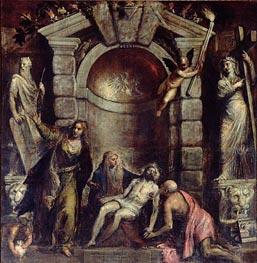Bacchus and Ariadne, c.1520/23 by Tiziano Vecellio Titian
Canvas Print - 4947-TTV
Location: National Gallery, London, United KingdomOriginal Size: 176.5 x 191 cm
Giclée Canvas Print | $68.45 USD
Your Selection
Customize Your Print
By using the red up or down arrows, you have the option to proportionally increase or decrease the printed area in inches as per your preference.
*Max printing size: 45.7 x 41.3 in
*Max framing size: Long side up to 28"
"Bacchus and Ariadne" will be custom-printed for your order using the latest giclée printing technology. This technique ensures that the Canvas Print captures an exceptional level of detail, showcasing vibrant and vivid colors with remarkable clarity.
Our use of the finest quality, fine-textured canvas lends art reproductions a painting-like appearance. Combined with a satin-gloss coating, it delivers exceptional print outcomes, showcasing vivid colors, intricate details, deep blacks, and impeccable contrasts. The canvas structure is also highly compatible with canvas stretching frames, further enhancing its versatility.
To ensure proper stretching of the artwork on the stretcher-bar, we add additional blank borders around the printed area on all sides.
Our printing process utilizes cutting-edge technology and employs the Giclée printmaking method, ensuring exceptional quality. The colors undergo independent verification, guaranteeing a lifespan of over 100 years.
Please note that there are postal restrictions limiting the size of framed prints to a maximum of 28 inches along the longest side of the painting. If you desire a larger art print, we recommend utilizing the services of your local framing studio.
*It is important to mention that the framing option is unavailable for certain paintings, such as those with oval or round shapes.
If you select a frameless art print of "Bacchus and Ariadne" by Titian, it will be prepared for shipment within 48 hours. However, if you prefer a framed artwork, the printing and framing process will typically require approximately 7-8 days before it is ready to be shipped.
We provide complimentary delivery for up to two unframed (rolled-up) art prints in a single order. Our standard delivery is free and typically takes 10-14 working days to arrive.
For faster shipping, we also offer express DHL shipping, which usually takes 2-4 working days. The cost of express shipping is determined by the weight and volume of the shipment, as well as the delivery destination.
Once you have added the paintings to your shopping cart, you can use the "Shipping estimates" tool to obtain information about available transport services and their respective prices.
All unframed art prints are delivered rolled up in secure postal tubes, ensuring their protection during transportation. Framed art prints, on the other hand, are shipped in cardboard packaging with additional corner protectors for added safety.
Painting Information
It is instructive to begin by acknowledging the painting’s original milieu. Commissioned for the Camerino d’Alabastro in the Ducal Palace of Ferrara, this painting belongs to a program that aligned classical narratives with contemporary artistic ambition. In the early sixteenth century, humanist scholars guided patrons to surround themselves with art drawn from antiquity’s rich literature. The story of Bacchus and Ariadne, informed by Ovid and Catullus, offered an ideal subject: it was at once a tale of abandonment, immediate rapture, and ultimate transcendence. Titian was chosen to contribute to this series, and he was determined to excel, fully aware that these mythological subjects were being set before an educated and discerning audience.
With this context in mind, it is possible to appreciate the methodical approach to technique and color. Titian has employed only the finest and most vibrant pigments available, and has used them in their purest forms. The vibrant ultramarine overhead, modulating toward the horizon, retains a brilliance and intensity that must have felt startlingly modern. Reds, greens, and earth tones form distinct clusters across the canvas, each hue standing fully on its own. These choices enliven the composition, imparting a sense of immediacy and clarity. Oil-rich glazes deepen the surface, allowing forms to glow with a subtle inner light.
Viewed compositionally, the painting arranges its protagonists with elegant restraint, ensuring that no element overwhelms another. Bacchus, poised mid-leap, enters from the right, while Ariadne occupies the left side, her body turning away in alarm. The direction of their gazes, the diagonal line of trees and revelers, and the scattered details of satyrs, felines, and distant sails all direct our attention to the central drama. The painter has succeeded in creating a tension that never collapses into disarray. Instead, the eye is led along a path, from the ragged entourage of Bacchus to the frightened but luminous Ariadne, and then outward toward distant seas, where Theseus’s ship recedes.
This path of looking prompts us to consider the narrative itself. Ariadne has been abandoned on Naxos, her hero-lover Theseus departing without so much as a backward glance. In that moment of despair, Bacchus appears, accompanied by a band of musicians, nymphs, and assorted mythic beings. His expression and gesture announce love at first sight, an instantaneous spark that reverberates through the painting. Ariadne’s initial terror and retreat are understandable. Yet beyond her earthly predicament, Titian has inserted another clue: the crown of stars that will eventually mark her place in the constellations, a poetic afterglow to this encounter.
In the handling of form and paint, one senses Titian’s deliberate challenge to the models of his time. He engages with classical sources, including the celebrated Laocoön sculpture, to confer a sense of authenticity and sculptural heft to these figures. Yet there is no stiffness or academic dryness; instead, a palpable liveliness animates each brushstroke. By treating the ancient story as both a visual feast of color and a suspended instant of drama, Titian ensures that the painting’s impact endures. In its own era, it extended the possibilities of painting as a medium of narrative and poetic invention. Viewed today, it continues to communicate the richness, ambition, and vitality of the Renaissance’s imaginative world.

Tiziano Vecellio Titian
Original Size:403 x 235 cm
Church of San Salvador, Venice, Italy

Tiziano Vecellio Titian
Original Size:389 x 351 cm
Gallerie dell'Accademia, Venice, Italy

Tiziano Vecellio Titian
Original Size:86 x 65 cm
Prado Museum, Madrid, Spain

Tiziano Vecellio Titian
Original Size:120 x 172 cm
Museo Nazionale di Capodimonte , Napoli, Italy

Tiziano Vecellio Titian
Original Size:137 x 88 cm
Museo Nazionale di Capodimonte , Napoli, Italy
















